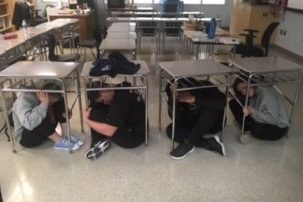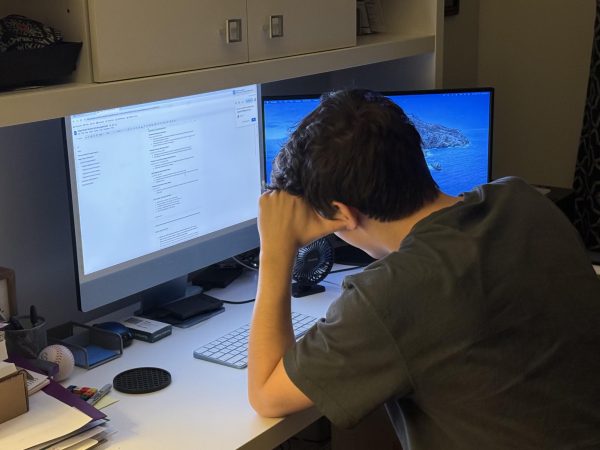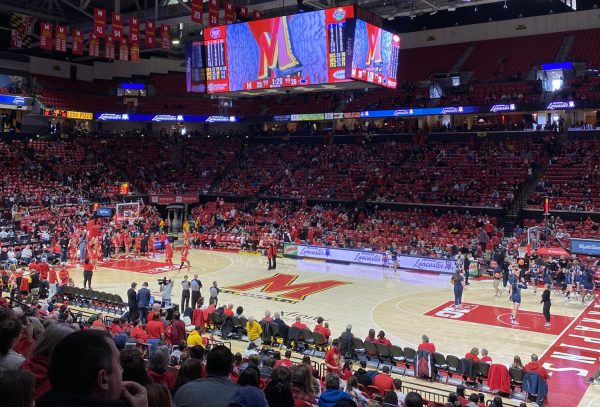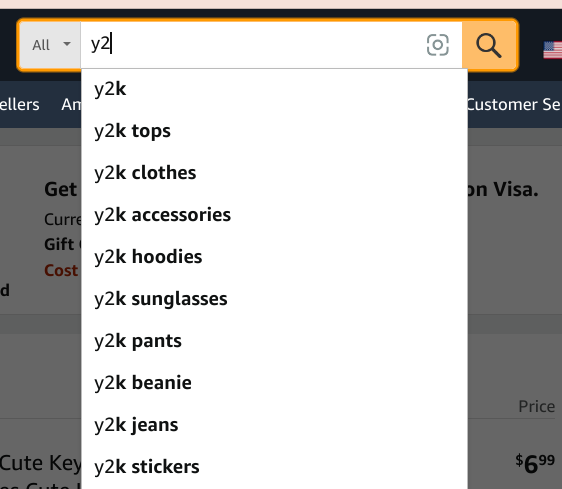Assessing School Safety Options: What to do next?

Studies have shown that the previous lock-down procedure of getting underneath desks is not a smart or safe option.
March 26, 2018
Every day, our school administration, county officials and members of our police force continue their efforts towards keeping students safe in schools. Numerous school shootings have occurred in America, most recently at Great Mills High School in Southern Maryland.
Schools such as Columbine, Sandy Hook, Stoneman Douglas and now Great Mills, are all schools that have been subject to school shootings. Not many people know where these schools are located, or even the names of the victims who are affected by these tragedies.
In early March 2018, 7,000 pairs of shoes were places on the lawn of the U.S. Capitol. The shoes symbolized the number of children killed by gun violence since 2001… 7,000 shoes… What makes this image even more disheartening is that nothing has been done to combat this issue.
Students are stepping up and speaking the truth to the general public. We need a change in the behavior and actions of all Americans in the future.
Conversations going forward
People are quick to blame one specific group or problem as the sole culprit of school shootings. I do not believe this should be the case. These terrible tragedies are occurring because many problems have compounded over the years. Easy access to guns is not the only reason these shootings are occurring. Mental health, easy access to semi-automatic and automatic weapons, bullying and poor home environments are just a few contributors to this issue.
Well then what do we do?
Buy a Bulletproof Backpack?
Parents all across the country have started to talk about bulletproof backpacks. Sales have increased by 200-300% since the shooting in Parkland, Florida.
However, bulletproof backpacks aren’t really bulletproof at all — more like “selectively bulletproof.” They have been proven to prevent injury from bullets of a low velocity weapon, such as a pistol or a rifle. As of 2017, the highest percentage of school shootings have involved the use of a semi-automatic or automatic weapons that release high velocity rounds. Bullets from these types of weapons have proven to be too powerful for bulletproof backpacks to handle. These backpacks only “lessen the blow” from the bullets of semi-automatic or automatic weapons. Simply put, bulletproof backpacks are not an effective way to protect students in the case of a school shooting.
Cost is another issue with these ‘high tech’ backpacks. Their price ranges from 189-490 dollars, which is way too much money to pay considering the lack of protection they provide.
If worn all day every single day of the week, these backpacks could be effective; however, that possibility is highly unlikely. Bulletproof backpacks don’t seem like a smart or safe option here.
Maybe Metal Detectors?
Having metal detectors at the entrances of schools does have some perks. There are schools around the country that have already implemented metal detectors. These schools have shown a decline in the levels of school violence in their areas. However, The National Center for Education Statistics concluded that the presence of metal detectors in schools has only decreased the amount of violence by less than 10%. More than anything, metal detectors provide a psychological sense of assurance among students and staff.
Metal detectors don’t just prevent against gun violence. They prevent against violence from other weapons, such as knives and bombs. The immediate detection of any possible threat makes this the best option, so far, for preventing weapons from entering schools and leading to violence.
Time and lack of resources are two huge downfalls to this possible solution. A school in Worcester, Massachusetts, implemented metal detectors in five of its counties schools. They had to completely restructure their class periods in order to compensate for the ‘traffic jam’ that metal detectors caused. The schools staggered their first periods to allow for smaller groups of students to enter through the metal detectors at a time. Clearly, metal detectors aren’t simply a cut and dry solution.
It’s inevitable that the detection would go off for the slightest detection of a metal object. Who is then going to check all of those students that set off the detector alarm? Full-time trained staff members would need to be at the metal detector station 24/7, monitoring who enters and exits the building. These staff members would most likely be trained police officers.
There is nowhere nearly enough money in local or state budgets for such a task. The cost of the metal detector itself ranges from $3,000-$5,000. However, the initial cost of the metal detector itself is minimal comparable to the ongoing costs of maintenance. The installation cost of five metal detectors in Worcester, Massachusetts was almost $100,000. In those five schools, $86,587 has been spent in expenses, mostly for repairs and maintenance. That doesn’t include added expense of the salaries for all police officers that are there to monitor the detection process.
The overall cost of implementing metal detectors into all the middle and high schools in Frederick County, Maryland alone would be in the millions. Think about that number in relation to how many middle and high schools are in the state of Maryland. Neither the county nor the state has anywhere near the amount of money that would be needed for such a sizable project. The amount of resources needed to effectively run metal detectors in schools is overwhelmingly high, and, quite frankly, the task is likely an impossible one.
Teachers with guns? Oh no!
This idea absolutely blows my mind. How can anyone think that arming teachers is the answer to this problem? When will all the teachers have time to be properly trained how to use a weapon? How will teachers keep the gun(s) in their classrooms without students having access to them? Where will the government get the money to fund this massive investment? All of these questions pose serious and valid concerns.
Although the idea sounds completely absurd, 18 states in the US already allow adults to carry guns on campus. Some of these states include Kentucky, Texas, Wyoming, Alabama, Oregon, New Jersey, Mississippi and California.
In the most recent school shooting, at Great Mills High School in Southern Maryland, the Student Resource Officer responded to the incident in a matter of 60 seconds. The SRO protected the safety of the rest of the staff and students in the school by responding to the incident in an extremely time-efficient manner. Student Resource Officers are trained to use a weapon. They are paid to know how to do that, it’s their job. The example of Great Mills High School goes to show how Student Resource Officers can provide a lot of protection for members of a school. Teachers have no need to carry guns when it’s the SRO’s job to do so in the first place.
More Lock-down Drill Practices?
Schools, such as Linganore, are now implementing stricter safety-related policies. Students aren’t used to the doors being locked at all times, signing out every time they leave the classroom, and having a more restricted access to school after hours. Teachers aren’t used to swiping in to enter the building either. These policies create more of an inconvenience rather than prevent school violence.
Linganore’s Student Resource Officer, Deputy Jones, says that most of these policies have been implemented since 2013 but haven’t been strictly enforced. In order to improve school safety, all school communities must walk the walk and talk the talk of school safety. This means following the rules, even though they seem like a hassle.
Why are schools not better preparing students for how to react in this type of situation? Maryland law requires its public schools to have ten fire drills per school year but only one evacuation, lock-down and severe weather drill. The National Fire Protection Association reported that the last time anyone died in a school fire was in December 1958 at a high school in Chicago, Illinois.
In 2018 alone, there have been eleven school shootings that have all resulted in loss of life, so why do we practice a drill for natural disaster ten times more? These disasters haven’t resulted in loss of life in many decades. We need drills that prepare students for how to act in a situation that has become a frequent occurrence. This logic doesn’t make sense to me. Schools should be preparing their students for situations that are likely to happen. This isn’t by any means justifying school shootings. It is simply stating that students and staff need to be properly trained on how to act in a situation that is more likely to occur.
The Solution
In a Lancer Media pole, 49% of people believe that none of the given categories – bulletproof backpacks, metal detectors or arming teachers with guns – will make schools safer. If none of these options seem logical, then what should we do?
Many school shooters are not current students of the school and have no reason to be inside the building. Take the shooting Stoneman Douglas High School for example. The shooter, an expelled student, entered the building during the time when classes were changing and pulled the fire alarm, which caused students and staff to exit the school. The shooter shouldn’t have been able to enter the school to pull the fire alarm in the first place.
Staff members have to now swipe their identification cards every time they want to enter the building, so why shouldn’t students have to do this also? This would only allow staff and currently enrolled students to enter the building at all times, preventing anyone else from entering. A student resource officer (SRO) should be in the front office at all times to monitor anyone else who seeks entry into the school.
There isn’t an easy way to solve the issue of gun violence in schools. There are so many factors that affect how this solution should be approached. Regardless, something needs to be done and fast. Maryland state law should change to require the practice of more lock-down and evacuation drills compared to the excessive amount of currently required fire drills. This would better prepare students for a situation they could possibly encounter.
The issue of safety in our nation’s schools affects thousands of people all across the country. It needs to be a topic of discussion by local, state and federal governments. We need to come together, as concerned citizens of America, to make a change for the greater good of our country and its citizens.












